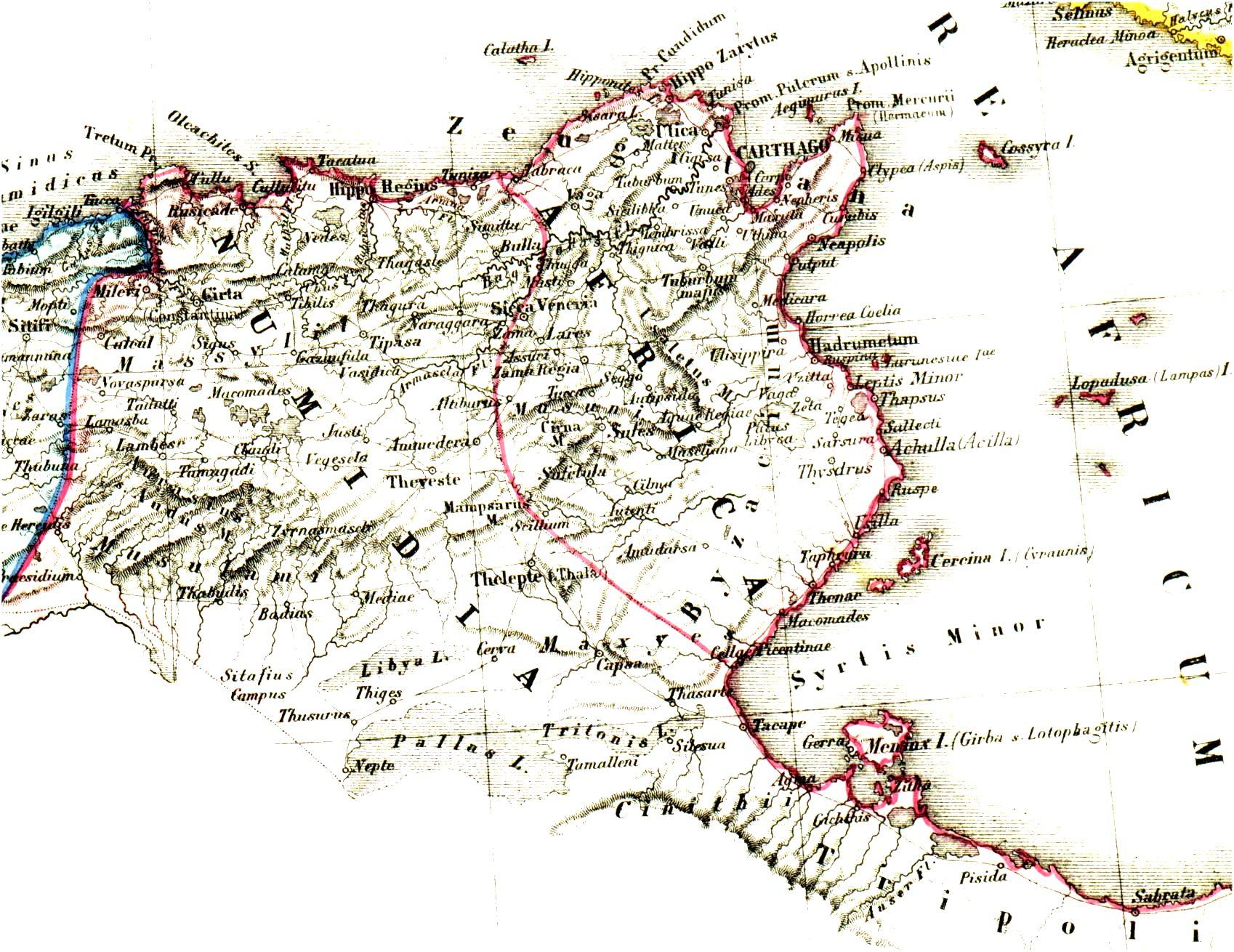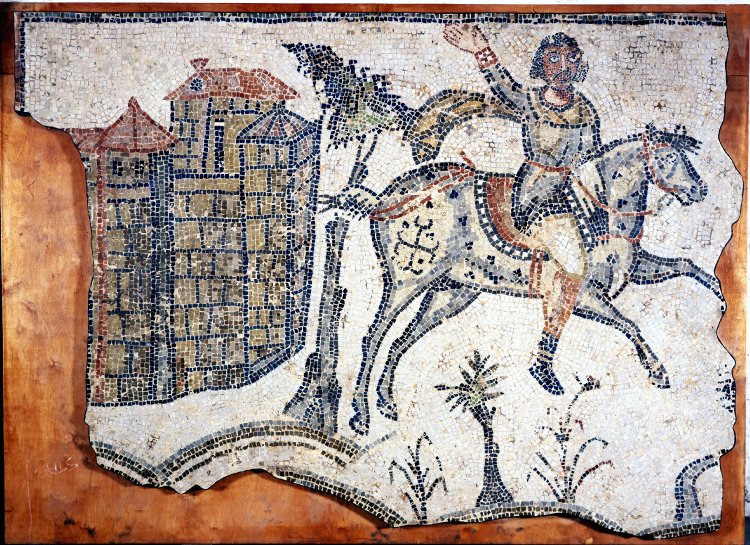|
Mauro-Roman Kingdom
The Mauro-Roman Kingdom (Latin: ''Regnum Maurorum et Romanorum'') was an independent Christian Berber kingdom centred in the capital city of Altava (present-day Algeria) which controlled much of the ancient Roman province of Mauretania Caesariensis. The kingdom was first formed in the fifth century as Roman control over the province weakened and Imperial resources had to be concentrated elsewhere, notably in defending the Italian Peninsula itself from invading Germanic tribes. The rulers of the Mauro-Roman Kingdom repeatedly came into conflict with the Vandals of the neighbouring Vandalic Kingdom, which had been established following the Vandalic conquest of the Roman province of Africa. King Masuna of the Moors and Romans allied with the armies of the Eastern Roman Empire during their reconquest of Northern Africa in the Vandalic War. Following the Eastern Roman victory over the Vandals, the Mauro-Roman Kingdom maintained its alliance with the Eastern Roman Empire, assisting ... [...More Info...] [...Related Items...] OR: [Wikipedia] [Google] [Baidu] |
Kingdom Of Altava
The Kingdom of Altava was an independent Berber kingdom centered on the city of Altava in present-day northern Algeria. The Kingdom of Altava was a successor state of the previous Mauro-Roman Kingdom which had controlled much of the ancient Roman province of Mauretania Caesariensis and during the reign of Kusaila extended from Volubilis in the west to the Aurès and later Kairaouan and the interior of Ifriqiya in the east. This Kingdom collapsed following Eastern Roman military campaigns to decrease its influence and power after Garmul invaded the Exarchate of Africa.Martindale (1980), pp. 509-510 The collapse of the Mauro-Roman Kingdom lead to the rise of several petty berber kingdoms in the region, including the Kingdom of Altava, which was centered on the capital of the older kingdom. The kingdom continued to exist in the Maghreb until the conquest of the region by the Umayyad Caliphate in the seventh and eighth centuries. History Background The Mauro-Roman Kin ... [...More Info...] [...Related Items...] OR: [Wikipedia] [Google] [Baidu] |
Western Roman Empire
The Western Roman Empire comprised the western provinces of the Roman Empire at any time during which they were administered by a separate independent Imperial court; in particular, this term is used in historiography to describe the period from 395 to 476, where there were separate coequal courts dividing the governance of the empire in the Western and the Eastern provinces, with a distinct imperial succession in the separate courts. The terms Western Roman Empire and Eastern Roman Empire were coined in modern times to describe political entities that were ''de facto'' independent; contemporary Romans did not consider the Empire to have been split into two empires but viewed it as a single polity governed by two imperial courts as an administrative expediency. The Western Roman Empire collapsed in 476, and the Western imperial court in Ravenna was formally dissolved by Justinian in 554. The Eastern imperial court survived until 1453. Though the Empire had seen periods wit ... [...More Info...] [...Related Items...] OR: [Wikipedia] [Google] [Baidu] |
Praetorian Prefecture Of Africa
The praetorian prefecture of Africa ( la, praefectura praetorio Africae) was an administrative division of the Eastern Roman Empire in the Maghreb. With its seat at Carthage, it was established after the reconquest of northwestern Africa from the Vandals in 533–534 by the Byzantine Emperor Justinian I. It continued to exist until 591, when it was replaced by the Exarchate of Africa. History Establishment In 533, the Roman army under Belisarius defeated and destroyed the Vandal Kingdom that had existed in the former Roman territories of Northern Africa. Immediately after the victory, in April 534, the emperor Justinian published a law concerning the administrative organization of the recovered territories. The old provinces of the Roman Diocese of Africa had been mostly preserved by the Vandals, but large parts, including almost all of Mauretania Tingitana, much of Mauretania Caesariensis and Mauretania Sitifensis and large parts of the interior of Numidia and Byzacena ... [...More Info...] [...Related Items...] OR: [Wikipedia] [Google] [Baidu] |
Kingdom Of The Aurès
The Kingdom of the Aurès (Latin: ''Regnum Aurasium'') was an independent Christian Berber kingdom primarily located in the Aurès Mountains of present-day north-eastern Algeria. Established in the 480s by King Masties following a series of Berber revolts against the Vandalic Kingdom, which had conquered the Roman province of Africa in 435 AD, Aurès would last as an independent realm until the Muslim conquest of the Maghreb in 703 AD when its last monarch, Queen Dihya, was slain in battle. Much like the larger Mauro-Roman Kingdom, the Kingdom of the Aurès combined aspects of Roman and Berber culture in order to efficiently rule over a population composed of both Roman provincials and Berber tribespeople. For instance, King Masties used the title of '' Dux'' and later ''Imperator'' to legitimize his rule and openly declared himself a Christian. Despite this, Aurès would not recognize the suzerainty of the remaining Roman Empire in the East (often called the Byzantine Empire b ... [...More Info...] [...Related Items...] OR: [Wikipedia] [Google] [Baidu] |
Vandalic War
The Vandalic War was a conflict fought in North Africa between the forces of the Byzantine Empire and the Vandalic Kingdom of Carthage in 533–534. It was the first of Justinian I's wars of reconquest of the Western Roman Empire. The Vandals occupied Roman North Africa in the early 5th century, and established an independent kingdom there. Under their king, Geiseric, the Vandal navy carried out pirate attacks across the Mediterranean, sacked Rome and defeated a Roman invasion in 468. After Geiseric's death, relations with the Eastern Roman Empire normalized, although tensions flared up occasionally due to the Vandals' adherence to Arianism and their persecution of the Nicene native population. In 530, a palace coup in Carthage overthrew the pro-Roman Hilderic and replaced him with his cousin Gelimer. The Eastern Roman emperor Justinian took this as a pretext to intervene in Vandal affairs, and after securing the eastern frontier with Sassanid Persia in 532 he began preparing ... [...More Info...] [...Related Items...] OR: [Wikipedia] [Google] [Baidu] |
Eastern Roman Empire
The Byzantine Empire, also referred to as the Eastern Roman Empire or Byzantium, was the continuation of the Roman Empire primarily in its eastern provinces during Late Antiquity and the Middle Ages, when its capital city was Constantinople. It survived the fragmentation and fall of the Western Roman Empire in the 5th century AD and continued to exist for an additional thousand years until the fall of Constantinople to the Ottoman Empire in 1453. During most of its existence, the empire remained the most powerful economic, cultural, and military force in Europe. The terms "Byzantine Empire" and "Eastern Roman Empire" were coined after the end of the realm; its citizens continued to refer to their empire as the Roman Empire, and to themselves as Romans—a term which Greeks continued to use for themselves into Ottoman times. Although the Roman state continued and its traditions were maintained, modern historians prefer to differentiate the Byzantine Empire from Ancient ... [...More Info...] [...Related Items...] OR: [Wikipedia] [Google] [Baidu] |
Vandals
The Vandals were a Germanic people who first inhabited what is now southern Poland. They established Vandal kingdoms on the Iberian Peninsula, Mediterranean islands, and North Africa in the fifth century. The Vandals migrated to the area between the lower Oder and Vistula rivers in the second century BC and settled in Silesia from around 120 BC. They are associated with the Przeworsk culture and were possibly the same people as the Lugii. Expanding into Dacia during the Marcomannic Wars and to Pannonia during the Crisis of the Third Century, the Vandals were confined to Pannonia by the Goths around 330 AD, where they received permission to settle from Constantine the Great. Around 400, raids by the Huns from the east forced many Germanic tribes to migrate west into the territory of the Roman Empire and, fearing that they might be targeted next, the Vandals were also pushed westwards, crossing the Rhine into Gaul along with other tribes in 406. In 409, the Vandals c ... [...More Info...] [...Related Items...] OR: [Wikipedia] [Google] [Baidu] |
Mauretania Caesariensis
Mauretania Caesariensis (Latin for " Caesarean Mauretania") was a Roman province located in what is now Algeria in the Maghreb. The full name refers to its capital Caesarea Mauretaniae (modern Cherchell). The province had been part of the Kingdom of Mauretania and named for the Mauri people who lived there. Formerly an independent kingdom, and later a client state of Rome, it was annexed into the Empire formally during the reign of Claudius and divided into two provinces about 42 AD. A third province, named Mauretania Sitifensis, was later split off from the eastern portion during the reign of Diocletian in 293 AD. During and after the Fall of the Western Roman Empire in the 5th century, most of the hinterland area was lost, first to the Vandal Kingdom and later to the Mauro-Roman Kingdom, with Roman administration limited to the capital of Caesarea. The land was reconquered by Rome during the reign of Justinian. This province was a part of Praetorian prefecture ... [...More Info...] [...Related Items...] OR: [Wikipedia] [Google] [Baidu] |
Ancient Rome
In modern historiography, ancient Rome refers to Roman civilisation from the founding of the city of Rome in the 8th century BC to the collapse of the Western Roman Empire in the 5th century AD. It encompasses the Roman Kingdom (753–509 BC), Roman Republic (509–27 BC) and Roman Empire (27 BC–476 AD) until the fall of the western empire. Ancient Rome began as an Italic settlement, traditionally dated to 753 BC, beside the River Tiber in the Italian Peninsula. The settlement grew into the city and polity of Rome, and came to control its neighbours through a combination of treaties and military strength. It eventually dominated the Italian Peninsula, assimilated the Greek culture of southern Italy (Magna Grecia) and the Etruscan culture and acquired an Empire that took in much of Europe and the lands and peoples surrounding the Mediterranean Sea. It was among the largest empires in the ancient world, with an estimated 50 to 90 million inhabitants, roughly ... [...More Info...] [...Related Items...] OR: [Wikipedia] [Google] [Baidu] |




.jpg)



